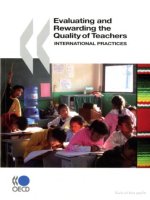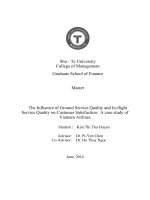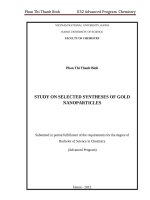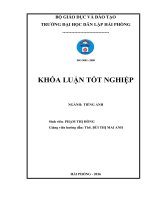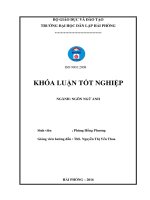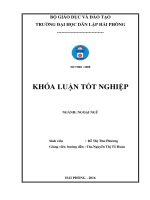Effect of Acidified Sodium Chlorite against microbial contamination and maintain the quality of mung bean (Khóa luận tốt nghiệp)
Bạn đang xem bản rút gọn của tài liệu. Xem và tải ngay bản đầy đủ của tài liệu tại đây (1.36 MB, 53 trang )
THAI NGUYEN UNIVERSITY
UNIVERSITY OF AGRICULTURE AND FORESTRY
PHAM THI CHUYEN
Effect of Acidified Sodium Chlorite Against Microbial
Contamination and Maintain The Quality of Mung Bean Sprout
BACHELOR THESIS
Study Mode
: Full-time
Major
: Post-Harvest Technology
Faculty
:Biotechnology and Food Technology
Batch
:2013 – 2017
Thai Nguyen, 12/06/2017
THAI NGUYEN UNIVERSITY
UNIVERSITY OF AGRICULTURE AND FORESTRY
PHAM THI CHUYEN
Effect of Acidified Sodium Chlorite Against Microbial
Contamination and Maintain The Quality of Mung Bean Sprout
BACHELOR THESIS
Study Mode
: Full-time
Major
: Post-Harvest Technology
Faculty
: Biotechnology and Food Technology
Batch
: 2013 – 2017
Supervisors
: Assoc. Prof. Dr. Pongphen Jitareerat
Ms. Trinh Thi Chung
Thai Nguyen, 12/06/2017
Thai Nguyen University of Agriculture and Forestry
Major
Post-Harvest Technology
Student name
Pham Thi Chuyen
Student ID
DTN1353140010
Thesis title
Supervisors
Effect of Acidified Sodium Chlorite against microbial
contamination and maintain the quality of mung bean
sprout
Assoc. Prof. Dr. Pongphen Jitareerat
Ms. Trinh Thi Chung
Abstract:
The use of suitable sanitizers can increase the quality and reduce the risk of
foodborne illnesses of mung bean sprout. The objective of this research was to study
the effects of acidified sodium chlorite (ASC which was prepared from mixture of
0.1g/l sodium chlorite and 5% citric acid, pH 2.3) to control microbial contamination
and maintain the quality of mung bean sprout. The optimal concentation (0.1, 0.25,
0.5 and 1.0 g/l) and dipping time (1, 5, 10, and 15 min) of ASC solution for
controlling browning of sprouts was investigated. The result revealed that 0.1 g/l
ASC for 1 min was the best concentration and dipping time for controlling
browning. This concentration and dipping time was selected to study its effects on
microbial decontamination and maintaining the quality of mung bean sprout in
compared with non-treated sprout, water washed sprout, and common sanitizing
agent (100 ppm sodium chlorite) treated sprout. All samples were then stored at
10°C for 5 days. The sprout treated with 0.1 g/l ASC for 1 min resulted in a
significant reduction of bialtotal bacteria, and coliform in comparing with the other
treatments. ASC treatment also maintained the quality of sprout by inhibiting the
browning as indicated by browning score and the changes of color (high L* value
and low a* value). Furthermore the treatment with ASC could delay weight loss but
did not show any significant negative effect on texture and total soluble solids
content. Sensory evaluation showed that ASC treated sprout had higher score of
color, odor, and over all acceptance than non-treated sprout. Therefore, this result
indicated that 0.1 g/l ASC for 1 min has the potential to minimize microbial growth
i
and maintaining quality of mung bean sprouts.
Key words
browning, coliform, food born pathogens, sanitizing agent,
sprout
Number of pages
43 pages
Date of Submission
12/06/2017
ii
ACKNOLEDGMENT
This thesis was completed by support and assistance of a number of people
whom I would like to personally thank. First and foremost, I would like to express my
gratitude to the both my supervisor, Assoc. Prof. Dr. Pongphen Jitareerat of the School
of Bioresources and Technology, King Mongkut’s University of Technology Thonburi
(KMUTT), Thailand and Master. Trinh Thi Chung from the Biotechnology and Food
Department of Thai Nguyen University of Agriculture and Forestry (TUAF), Vietnam.
Whose expertise, understanding, patience and provide valuable advice, support and
guidance during the my study.
A special thanks also to my lab teacher, Dr. Kanlaya Sripong, for sharing her
knowledge, inspiring ideas and discussions, both academic and non-academic. Thanks
for helping me all the time when I was doing my internship. Thanks you for always
being supportive and for taking care of me whenever I needed help.
I would like to thank every people on Post-harvest Technology Department and
special thank to all members Postharvest Pathology Laboratory at King Mongkut’s
University of Technology Thonburi for helping me fit in and feel welcome from the
moment and for the unlimited patience to explain me every doubts which I had during
my intership.
I would also like to all of my teacher in Faculty of Biotechnology and Food
Technology for teaching me how to become a good student, helping me how to get
knowledge and how to become a useful person.
And I wish to express my great gratitude to my friends whose support given
throughout the 6 months when I stayed at Thailand.
Finally, I would like to thanks my family, especially to my parents for their
unconditional love, overflowing support and words of encouragement. Words a truly
not enough to express how thankful I am to you.
iii
TABLE OF CONTENTS
PART I. INTRODUCTION ...................................................................................... 1
1.1 Researcher rationale ............................................................................................... 1
1.2. Objectives ............................................................................................................. 5
1.2.1 To determine the optimal concentration of ASC on browning inhibition
of
mung bean sprouts. ...................................................................................................... 5
1.2.2 To determine the effect of ASC dipping times on browning inhibition
of mung bean sprouts. .................................................................................................. 5
1.2.3 To study the effect of ASC on the microbial contamination and quality
of mung bean sprouts. .................................................................................................. 5
1.3. Scope of study ...................................................................................................... 5
1.3.1 To study effect of ASC concentration on browning inhibition of mung bean
sprouts. ........................................................................................................................ 5
1.3.2 To study effect of dipping time of ASC on browning inhibition of mung bean
sprouts ......................................................................................................................... 6
1.3.3 To study the effect of ASC on the microbial contamination and quality
of mung bean sprouts ................................................................................................... 6
PART II. MATERIALS AND METHODS .............................................................. 7
2.1. Materials ............................................................................................................... 7
2.2. Methods ................................................................................................................ 7
2.2.1 Experiment 1: To determine the optimal concentration of acidified sodium
chlorite (ASC) on browning inhibition on of mung bean sprouts. ................................ 7
2.2.2 Experiment 2: To determine the effect of acidified sodium chlorite (ASC)
dipping times on browning inhibition of mung bean sprouts ........................................ 7
2.2.3 Experiment 3: To study the effect of acidified sodium chlorite (ASC) on the
microbial contamination and quality of mung bean sprouts.......................................... 8
2.3 Parameters measurement........................................................................................ 9
2.3.1 Browning score ................................................................................................... 9
2.3.2 Color (L*, a*) ..................................................................................................... 9
iv
2.3.3 Weight loss ......................................................................................................... 9
2.3.4 Texture analysis .................................................................................................. 9
2.3.5 Total soluble solids ........................................................................................... 10
.2.3.6 Sensory evaluation ........................................................................................... 10
2.3.7 Microbial count ................................................................................................. 10
2.4 Statistical analysis ................................................................................................ 11
PART III. RESULTS AND DISCUSSION ............................................................. 12
3.1 To determine the optimal concentration of ASC on browning inhibition
of mung bean sprouts ................................................................................................. 12
3.2 Effect of ASC dipping times on browning inhibition of mung bean sprouts ......... 13
3.3 To study the effect of ASC on the microbial contamination and quality
of mung bean sprouts ................................................................................................. 15
3.3.1 Browning score ................................................................................................. 15
3.2.2 Color change (L* and a* values) ....................................................................... 16
3.2.4 Weight loss ...................................................................................................... 17
3.2.5 Texture (shear force) ......................................................................................... 18
3.2.5 Total soluble solids (TSS) ................................................................................. 19
3.2.6 Sensory evaluation ............................................................................................ 20
3.2.7 Total aerobe bacteria population ........................................................................ 23
3.2.8 Coliform population .......................................................................................... 24
DISCUSSION ........................................................................................................... 26
PART IV. CONCLUSION AND SUGGESTION .................................................. 30
4.1 Conclusion ........................................................................................................... 30
4.2 Suggestion ........................................................................................................... 30
v
LIST OF TABLES AND FIGURES
Table 1 Effect of concentration and dipping times of ASC on browning inhibition of
mung bean sprouts
Table 2 Effect of H2O, SH, ASC dip treatment on weight loss of mung bean sprouts
during storage at 10oC for 5 days
Table 3 Effect of H2O, SH, ASC dip treatment on texture of mung bean sprouts during
storage at 10oC for 5 days.
Table 4 Effect of H2O, SH, ASC dip treatment on brightness value of mung bean
sprouts during storage at 10oC for 5 days.
Table 5 Effect of H2O, SH, ASC dip treatment on a* value of mung bean sprouts
during storage at 10oC for 5 days.
Table 6 Effect of H2O, SH, ASC dip treatment on browning score of mung bean
sprouts during storage at 10oC for 5 days.
Table 7 Effect of H2O, SH, ASC dip treatment on color acceptance of mung bean
sprouts during storage at 10oC for 5 days.
Table 8 Effect of H2O, SH, ASC dip treatment on smell acceptance of mung bean
sprouts during storage at 10oC for 5 days.
Table 9 Effect of H2O, SH, ASC dip treatment on overall acceptance of mung bean
sprouts during storage at 10oC for 5 days.
Table 10 Effect of H2O, SH, ASC dip treatment on total soluble solids of mung bean
sprouts during storage at 10oC for 5 days.
Table 11 Effect of H2O, SH, ASC dip treatment on total bacteria population of mung
bean sprouts during storage at 10oC for 6 days.
Table 12 Effect of H2O, SH, ASC dip treatment on total coliform population of mung
bean sprouts during storage at 10oC for 6 days.
Figure 3.1 Effect ASC concentration to appearance of sprouts
Figure 3.2 Effect ASC concentration on browning inhibition of sprouts
Figure 3.3 Effect of ASC dipping times to appearance of sprouts
Figure 3.4 Effect ASC dipping times on browning inhibition of sprouts
Figure 3.5 Effect of H2O, SH, ASC dip treatment on browning score of sprouts
vi
Figure 3.6 Effect of H2O, SH, ASC dip treatment on L* value of sprouts
Figure 3.7 Effect of H2O, SH, ASC dip treatment on a* value of sprouts
Figure 3.8 Effect of H2O, SH, ASC dip treatment on weight loss of sprouts
Figure 3.9 Effect of H2O, SH, ASC dip treatment on texture of sprouts
Figure 3.10 Effect of H2O, SH, ASC dip treatment on total soluble solids of sprouts
Figure 3.11 Effect of H2O, SH, ASC dip treatment on color acceptance of sprouts
Figure 3.12 Effect of H2O, SH, ASC dip treatment on smell acceptance of sprouts
Figure 3.13 Effect of H2O, SH, ASC dip treatment on overall of sprouts
Figure 3.14 Effect of H2O, SH, ASC dip treatment on total aerobe bacteria of sprouts
Figure 3.15 Changes in mung bean sprouts total bacterial population
Figure 3.16 Effect of H2O, SH, ASC dip treatment on total coliform of sprouts
Figure 3.17 Changes in mung bean sprouts total coliform population
vii
LIST OF ABBREVIATIONS
ASC
Acidified sodium chlorite
SC
Sodium chlorite
CA
Citric acid
SH
Sodium hypochlorite
g/l
Gram/liter
ml
Milliliter
PCA
Plate Count Agar
EMB
Eosin Methylene Blue Agar
FDA
Food and Drug Administration
CDC
Centers for Disease Control
CFU/g
Colony forming units per gram
CFU/g-1
Colony forming unit
o
Degree celsius
C
min
Minute
C.V.
Coefficient of Variation
viii
PART I. INTRODUCTION
1.1 Researcher rationale
In the world, the increased consumption of seed sprouts in the past decades
which could be due to sprouts was an inexpensive product and good source of dietary
proteins, carbohydrates, minerals, and vitamins. According to Oregon Public Health
Division et al. (2005) reported that the most popular consumption of sprouts such as
alfalfa, mung bean, red clover, radish, broccoli and wheatgrass sprouts. In 2015, this
institution also showed that in sprout types, mung bean sprouts were the most
commonly consumed and it contained the high nutrient composition. This result
indicated by Dahiya et al. (2014) that mung bean sprouts contained 617 ppm iron, 247
ppm zinc, 13557 ppm calcium and an approximately 19.5-31.3% of protein ingredient
(Masood et al., 2014). In addition, the presence of approximately 20-24% protein and
50-60% carbohydrate was also founded by Tang et al. (2014). Besides, mung bean
sprouts contained other composition such as ascorbic acid, vitamin C, phosphorus,
potassium, sodium and other compounds which have possible health benefits, and it
was considered as potential benefits product for cancer prevention and suppression
(Muñoz et al, 2006).
Mung bean sprouts were allocated to many countries in the world include the
United States (Robertson et al., 2002; Bari et al., 2004) but the most popular in
Pakistan, Philippines, China, Korea, Japan, India and Bangladesh (Ali Siddiqui et al.,
2001; Hur and Kor, 2002. and Gabriel et al., 2007). With the increase in consumer
demand for the sprouts product can be causes the increase of foodborne illnesses
involved to bean sprouts because sprouts were regularly eaten raw (in salad and in
sandwiches) or slightly cooked as well as stir fry in oriental-type meals (Rajkowski
and Thayer, 2001; Robertson et al., 2005). Moreover, the production areas of all
producers were also found to be inappropriate for safe sprout production. The study by
Van Beneden et al. (1999) and Proctor et al. (2001) reported that the happening of
foodborne illness by consumption of raw sprouts as the critical risk factor.
According to statistics by FDA (Food and Drug Administration) and CDC
(Centers for Disease Control and Prevention) in recent years, caused high foodborne
illness outbreaks which were indicated as between 1996 and 2010 at United States
1
where it occurred 34 foodborne illness outbreaks led to 123 hospitalizations and one
death due to sprouts consumption (Johanson, 2012). A reported by FDA (2004) when
conducted investigation from 1996 to 2003 showed that caused to 25 foodborne illness
outbreaks related sprouts. CDC (2016) also investigated on raw sprouts between 2009
and 2016 and reported that there were 11 foodborne illness outbreaks. This pathogens
outbreaks popularly caused by Salmonella, E. coli and Listeria monocytogenes (CDC,
2016).
General, the increase of microbial amounts due to the inclusion of favorable
feature which needs to pathogens growth such as nutrients, pH, time, temperature,
oxygen and moisture. A study by Phue et al., (2014) found that mung bean sprouts
contained on average 9 log CFU/g total aerobic microorganisms and also contained
approximately 1.7х 107 CFU/g yeasts and molds when it was not treated (Tournas,
2005). Warriner et al. (2003) showed that when mung bean sprouts were inoculated by
E. coli and Salmonella montevideo, the pathogens became internalized. Moreover, in
the sprouts also existed other microbial such as Aeromonas hydrophila, Bacillus
cereus, and Staphylococcus aureus (Beuchat, 1995; Thompson and Powell, 2000).
Deering et al. (2012) also suggested that a conductive environment was created
surrounds of the pathogens which allowed the growth of microbial populations inside
boundaries of the plant.
However, the shelf life of the fresh-cut product (sprouts) is not only decided by
the microbial quality which caused product pathogens but also determined by
physiological quality. A study by Brecht (1995) showed that after processing, Freshcut vegetables (sprouts) still viable and their action could be compared with an
observed in plant tissues which were wounded or were exposed to pressure conditions.
This behaviour consists of the increase in respiration rate and ethylene production.
Beside, also occurred the wound-healing processes oxidative browning reaction and
lipid oxidation or water loss was increased.
A study evaluated by Yon (2012) indicated that the color was an important
sensory property with the role in determining product quality. In his study also
mentioned the major postharvest problems resulting in decreased in the commercial
value of fruits and vegetables. Browning of fruits and vegetables caused by polyphenol
2
oxidase (PPO) which was created due to the oxidation of phenolic compounds to oquinones, subsequently polymerize to form dark-color pigments (Jos-lyn and Ponting,
1951; Mayer and Harel, 1979). In addition, Ilker et al. (1977) and Mateos et al. (1993)
also showed that browning was one of the main causes of quality loss during the
postharvest storage of head lettuce and the processing of minimal lettuce. The studies
by He et al. (2008), Lu et al. (2007) found that the disorder of primary physiology
which caused the reduction of sensory quality and shelf life of fresh-cut apples.
Therefore, in order to understand the biochemical basis of browning and find
treatments to inhibit these color changes, the research expansion should be more
concerned (Hyodo et al., 1978; Ke and Saltveit, 1986d Siriphanich and Kader, 1985;
Fujita et al., 1991; Chazarra et al., 1996).
Along with the enzymatic browning control, the control of microbial
populations also was an important element to maintain quality and prolong the shelf
life of fresh-cut products, this confirmation was reported by Luo et al. (2011).
Recently, several agents which were used to prevent browning and reduced microbial
growth on mung bean sprouts also as fresh-cut products were found. There were many
reports investigated the effect of antimicrobial treatments on sprouts included physical,
chemical and biological treatments such as chlorine (Bang et al., 2011), ozone (Singla
et al., 2011), electrolyzed water (Zhang et al., 2011), heat (Jaquette et al., 1996),
chilling (Tian et al., 2012), irradiation (Saroj et al., 2007), supercritical carbon dioxide
(Jung et al., 2009), antagonistic microorganisms (Liao, 2008), antimicrobial
metabolites (Nandiwada et al., 2004) and bacteriophages (Ye et al., 2010). Several
agents were used to inhibit browning of fresh-cut product such as ascorbic acid,
calcium lactate, chlorine dioxide, cysteine, phytoncide, citric acid, calcium chloride,
sodium metabisulphite, L-cysteine and acetic acid (Martin-Diana et al., 2005; GómezLópez, 2008; Chen et al., 2010; Kim et al., 2014; Manolopoulou and Varzakas, 2013;
Ibrahim et al., 2004). In addition, McEvily et al. (1992) also indicated that based on
the working mechanisms of browning, can be divided into six groups which were able
to anti-browning included: reducing agents, acidulants, chelating agents, complexing
agents, enzyme treatments and enzyme inhibitors. However, there are the limited
information about antibrowning treatment on mung bean sprouts. Therefore, in order
3
to maintained quality of sprouts as well as fresh-cut products in postharvest
technology, the use a suitably sanitized solution as an urgent need for inhibited
browning and microbial growth.
Acidified sodium chlorite (ASC) which is combined by mixing a sodium
chlorite (NaClO2) solution and organic acid, it also is was sanitizing agent recently
accepted by FDA for a dip or spray application for food items, including fresh and
fresh-cut fruits and vegetables. ASC was indicated by an affection to pathogens
control such as the presence of Escherichia coli O157: H7, L. monocytogenes,
Salmonella Poona, etc. on fresh-cut carrots and cilantro (Allende et al., 2009;
Gonzalez et al., 2004; Ruiz-Cruz et al., 2006). Office of the Federal Register, U.S.
Government Printing Office (1999) also reported that ASC was used in poultry, red
meat, comminuted meat products, and fruit and vegetable products to decreased
bacterial contamination.
According to a study in ASC solution by Madduri (2007) reported that when
this solution was combined, metastable chlorous acid is formed in an equilibrium
reaction. Chlorous acid is a precursor to a series of strong oxidants (chlorate, chlorite,
chlorine dioxide) which able to kill bacteria, fungi, viruses, and algae. As a product
was produced from acidified sodium chlorite (ASC), Chlorine dioxide showed is a
disinfectant equal to or more effective than chlorine (Lillard, 1979), and it was also
found the oxidation capability in prevention bacteria, bacterial spores and virus
(Foegedineg et al., 1986; Lukasik et al., 2003). Several investigations mentioned the
effectiveness of aqueous chlorine dioxide to inhibit bacterial growth on the surface of
lettuce, cabbage, cucumber, and green pepper (Reina et al., 1995; Zhang and Farber,
1996; Han et al., 2001). In addition, Anon-ymous (1999) also proved that chlorine
dioxide was a strong oxidizing agent with oxidizing capability is about 2.5 times
higher than hypochlorous acid. These studies further demonstrated the effectiveness of
ASC in against microbial growth.
Moreover, ASC was also demonstrated is a potential browning inhibitor of the
fresh-cut industry. Luo et al. (2011) hypothesized that at low pH concentration (~2.5),
ASC may be able to control the browning reaction of fresh-cut apples. The study by
institutes such as CFIA (2001), FSANZ (2003), EFSA (2006), and FDA (2011) also
4
reported that the use of ASC at < 1,200 ppm sodium chlorite (SC) with pH levels from
2.3 to 2.9 has been demonstrated for the decontamination of food products (fish,
poultry, processed fruits and vegetables, and red meat). Sodium chlorite (SC) is a
major ingredient of ASC which was studied on their mechanism of browning
inhibition. SC acts as the inhibitor of polyphenol oxidase activity (He and Luo, 2007;
Lu et al., 2006; Lu et al., 2007). In addition, citric acid also widely used commercial as
an anti-browning agent, and is known to have inhibitory activity on polyphenol
oxidase in minimally processed fruits and vegetables ((Pizzocaro et al., 1993; Rocha et
al., 1998). Therefore, the combination of SC (sodium chlorite) and CA (citric acid) for
surface washing of products was extensively researched in fresh-cut produce. The
microbial decontaminated efficacy of ASC was often reported with different level,
because the reduction of microbial populations was affected by experimental
conditions such as inoculation process and washing methods (Singh et al., 2002). In
addition, there have been limited reports dealing with the washing effectiveness of
ASC on microbial control including aerobic plate counts, coliforms, as well as the
browning control of fresh-cut root vegetables in general and sprouts products in
particular.
Therefore, the objective of this study was to evaluate the effects of ASC
treatment on a reduction of microbial growth and maintenance of the quality of mung
bean sprouts.
1.2. Objectives
1.2.1 To determine the optimal concentration of ASC on browning inhibition of
mung bean sprouts.
1.2.2 To determine the effect of ASC dipping times on browning inhibition of mung
bean sprouts.
1.2.3 To study the effect of ASC on the microbial contamination and quality of
mung bean sprouts.
1.3. Scope of study
1.3.1 To study effect of ASC concentration on browning inhibition of mung bean
sprouts.
5
The mung bean sprout was treated with ASC solution at 0.1-1.0 g/l for 1 min
before stored at 10°C. The browning score was assessed 7 days.
1.3.2 To study effect of dipping time of ASC on browning inhibition of mung bean
sprouts
The mung bean sprout was treated with 0.1 g/l ASC solution for 1, 5, 10, and 15
min before stored at 10°C. The browning score was assessed 7 days.
1.3.3 To study the effect of ASC on the microbial contamination and quality of
mung bean sprouts
The mung bean sprout was treated with 0.1 g/l ASC solution for 1 min before
stored at 10°C. The quality of treated sprouts such as browning score, changes of
color, weight loss, texture, total soluble solids content, and sensory test were
determined during storage for 5 days, the microbial population such as total bacteria,
and Coliform were determined during storage for 6 days.
6
PART II. MATERIALS AND METHODS
2.1. Materials
Mung beans sprouts are produced in the laboratory of the postharvest
technology, King Mongkut’s University of Technology Thonburi. Sprouts were
handled basic and were selected to obtain damage-free and uniform size and color to
prepared for experiments.
2.2. Methods
2.2.1 Experiment 1: To determine the optimal concentration of acidified sodium
chlorite (ASC) on browning inhibition on of mung bean sprouts.
Mung bean sprouts prepared as described on above. The sprouts were dipped in
different concentration of ASC solutions whereas mung bean sprout treated with
sodium hypochlorite and tap water were used as the controls. All treatments were
shown as follows:
Treatment 1 = Dipped with tap water at room temperature for 1 minute (Control 1)
Treatment 2 = Dipped with 0.1 g/l SH (Sodium hypochlorite) for 1 minute
(Control 2)
Treatment 3 = Dipped with 0.1 g/l ASC for 1 minute
Treatment 4 = Dipped with 0.25 g/l ASC for 1 minute
Treatment 5 = Dipped with 0.5 g/l ASC for 1 minute
Treatment 6 = Dipped with 1 g/l ASC for 1 minute
After treating, the exceed solution or water was removed by handle spinner.
Twenty grams of sprouts from each treatment was placed on the foam tray and covered
with PVC film. The samples were then kept at 10°C for 7 days to evaluate the
browning score. Each treatment had replicates (trays). Browning score of sprout was
evaluated on day 0, 1, 2, 3, 4, and 7 acccording to the method of Junkwon et al.
(2015). The area of surface browning of the sprouts was scored from the percentage of
browning intensity of 0 to 3 when 0 = <10%, 1 = 11-25%, 2 = 26-50%, and 3 >50%.
2.2.2 Experiment 2: To determine the effect of acidified sodium chlorite (ASC)
dipping times on browning inhibition of mung bean sprouts
Mung bean sprouts prepared as described on above. The sprouts were dipped in
0.1 g/l ASC solution for 1, 5, 10, and 15 min. Mung bean sprout treated with 100 ppm
7
sodium hypochlorite (SH) or tap water were used as the controls. All treatments were
shown as follows:
Treatment 1 = Dipped with tap water at room temperature for 1 minute
(control 1)
Treatment 2 = Dipped with 0.1 g/l SH (Sodium hypochlorite) for 1 minute
(Control 2)
Treatment 3 = Dipped with 0.1g/l SH for 1 minute
Treatment 4 = Dipped with 0.1 g/l ASC for 1 minute
Treatment 5 = Dipped with 0.1 g/l ASC for 5 minutes
Treatment 6 = Dipped with 0.1 g/l ASC for 10 minutes
Treatment 7 = Dipped with 0.1 g/l ASC for 15 minutes
After treating, the exceed solution or water was removed by handle spinner.
Twenty grams of sprout from each treatment was placed on the foam tray and covered
with PVC film. The samples were then kept at 10°C for 7 days to evaluate the
browning score. Each treatment had 3 replicates trays). Browning score of sprout was
evaluated on day 0, 1, 2, 3, 4, and 7 according to the method of Junkwon et al. (2015).
The area of surface browning of the sprouts was scored from the percentage of
browning intensity of 0 to 3 when 0 = <10%, 1 = 11-25%, 2 = 26-50%, and 3 >50% of
browning intensity.
2.2.3 Experiment 3: To study the effect of acidified sodium chlorite (ASC) on the
microbial contamination and quality of mung bean sprouts
Mung bean sprouts prepared as described on above. The sprouts were dipped in
0.1 g/l ASC solution for 1 min. Mung bean sprout treated with 0.1 g/L (or 100 ppm)
sodium hypochlorite (SH) or tap water were used as the controls. All treatments were
shown as follows:
Treatment 1 = Non-dipped sample (Negative control 1)
Treatment 2 = Dipped with tap water at room temperature for 1 min
(Negative control 2)
Treatment 3 = Dipped with 0.1g/l SH (sodium hypochlorite) for 1 minute
(Positive control)
Treatment 4 = Dipped with 0.1 g/l ASC for 1 minute
8
After treating, the exceed solution or water was removed by handle spinner.
Thirty grams of sprout from each treatment was placed on the polypropylene (PP) tray
and covered with PVC film. The samples were then kept at 10°C for 6 days. Each
treatment consisted with 3 replicates (trays). The quality of sprout (browning score,
changes of color, weight loss, texture, total soluble solids content, and sensory test)
were determined 5 days during storage whereas the microbial growth (total bacteria,
E.coli, and Coliform) were determined 6 days interval.
2.3 Parameters measurement
2.3.1 Browning score
Browning score of sprout was evaluated according to the method of Junkwon et
al. (2015). The area of surface browning of the sprouts was scored from the percentage
of browning intensity of 0 to 3 where; 0 = <10%, 1 = 11-25%, 2 = 26-50%, and 3
>50% of browning intensity.
2.3.2 Color (L*, a*)
Color changes of mung bean sprouts were determined using colorimeter (CR
400, Minolta, Japan). The value of a* and L* from each replication (sprouts) was
measured. The L* value shows lightness or darkness of the sprouts, while a* value
shows the green to red color as it moves from negative and positive value. Three
replicates were used per treatments. Results were reported as average of individual
values as L* (lightness) or a*.
2.3.3 Weight loss
Weights of mung bean sprouts were determined using electronic weighing
balance every day until the end of the experiment. Weight was recorded in 3
replications for each treatment, and weight loss was determined as a percentage of
initial weight at the start of the experiment. The calculation was done using the
following formula.
WL(%)=[
* 100……………………………………………….
Where; WL, weight loss; D0, initial weight; and D1, weight at the time.
2.3.4 Texture analysis
The mung bean sprouts texture was determined as shearing force using texture
analyzer (TA. XT Plus, UK), with a 10 mm distance, and pretest and posttest speeds of
9
2.00 and 10.00 mm/s, respectively. In this study, the shear forces were determined on
the stem part of the mung bean sprout by cutting through with a shear blade at the
middle part of sprouts. Four replicates with 3 sprouts each were analyzed and data was
reported as Newton (N).
2.3.5 Total soluble solids
Total soluble solids (TSS) contents were measured by hand digital
refractometer (Brix 0-32%, Atago, PAL-1, Japan). The mung bean sprouts was
crushed with mortar and pestle. The supernatant of sprouts was obtained by squeezing
out using clean pieces of cloth. The supernatants from each sample were used to
measure total soluble solids. The data was reported as °Brix.
.2.3.6 Sensory evaluation
The sensory evaluation of sprout was conducted using ta least 5 untrained
panelists. The sensory test was conducted following techniques at the Quartermaster
and the University of Chicago. The questionnaire was designed to collect information
on color acceptance, odor (smell) acceptance and overall acceptance of the product. A
9-points hedonic scale was used in collecting key information from the give sprout
samples and was indicated as following:
9 = Like extremely
4 = Dislike slightly
8 = Like very much
3 = Dislike moderately
7 = Like moderately
2 = Dislike very much
6 = Like slightly
1 = Dislike extremely
5 = Neither like or dislike
2.3.7 Microbial count
A 25 g of mung bean sprouts was randomly taken from each replication and
transferred to 225 ml of sterile peptone water soluble. The sample was placed in the
stomacher and shook for 60 seconds. The suspension from each sample was diluted
and used to determine the population of microbial. Serial dilution of this solution (0.1
ml) was performed in the triplicate standard method using Plate Count Agar (PCA)
plates to determine the total aerobe bacteria, Eosin Methylene Blue (EMB) agar plates
to determine the Escherichia coli (E. coli) and coliform enumeration. The amounts of
10
colonies were counted after 24 hr for PCA medium and 48hr for EMB medium after
incubating at 37°C. Microbial counts were expressed as log CFU/g fresh weight.
2.4 Statistical analysis
Three replicates per treatment were used in the experiments. All data points
represent the mean ± SD of the three replications. Analysis of variance (ANOVA)
followed by Duncan’s Multiple Range Test with a significance level of, P<0.05, and
correlation test was performed on data using the statistic software SAS (SAS Institute, 1989).
11
PART III. RESULTS AND DISCUSSION
3.1 To determine the optimal concentration of ASC on browning inhibition of
mung bean sprouts
The browning symptom and browning score in mung bean sprouts treated with
ASC at different concentrations for 1 min are shown in Figure 3.1 and Figure 3.2 in
compared with sodium hypochlorite (SH) treatment and tap water treatment (control).
Sprout treated with 0.1 and 0.5 g/l ASC showed significant lower browning score than
the control since 1th until 4th day of storage (p<0.05). Among of treatments, the samples
were treated with 0.1 g/l ASC for 1 minute discovered the lowest browning score
value. However, on day 7, no significant difference was showed between all
treatments, and the sprouts were treated by 100 ppm SH for 1 minute indicated the
highest score value compared to other treatment.
Tap with H2O
100 ppm SH,
1 min
0.1 g/l ASC,
1 min
0.25 g/l ASC,
1 min
0.5 g/l ASC,
1 min
1 g/l ASC,
1 min
Day 0
Day 1
Day 2
Day 3
Day 4
Day 7
Figure 3.1 The appearance of mung bean sprout after treating with acidified sodium
chlorite (ASC) at 0, 0.1, 0.25, 0.5, and 1.0 g/l for 1 min compared to sprout treated
tap water and sodium hypochlorite (SH). All samples were stored at 10°C for 7 days.
12
Browning score
4
control, H2O
SH 100 ppm
ASC 0.1 g/l
ASC 0.25 g/l
ASC 0.5 g/l
ASC 1 g/l
*
3
*
2
*
*
2
3
1
0
0
1
4
7
Day of storage
Figure 3.2 Effect acidified sodium chlorite (ASC) at different concentrations on
browning inhibition of mung bean sprout during storage at 10°C for 7 days. The
sprout treated with tap water and sodium hypochlorite (SH) were served
as the controls.
3.2 Effect of ASC dipping times on browning inhibition of mung bean sprouts
Figure 3.3 and 3.4 show the appearance and browning score of mung bean
sprout respectively. The effect of ASC dipping time on browning inhibition of mung
bean sprout was observed during storage at 10°C for 7 days. The brown color
gradually presented towards from the initially day to the end of storage period. No
significant difference in browning was observed between all treatments in during of
storage. But it seemed to observe that the sprout samples treated with 0.1 g/l ASC for 1
and 15 min had the lowest value of the browning score. Furthermore, the highest
browning score was discovered in 100 ppm SH treated sprout. This result indicated
that SH treatment does not have antibrowning activity.
13
Tap with
H2O
100 ppm
SH, 1 min
0.1g/l
ASC, 1min
0.1 g/l ASC,
5 min
0.1 g/l ASC,
10 min
0.1 g/l ASC,
15 min
Day 0
Day 1
Day 2
Day 3
Day 4
Day 7
Figure 3.3 The appearance of mung bean sprout after treating with 0.1 g/l acidified
sodium chlorite (ASC) for 1, 5, 10 and 15 min compared with sprout treated with tap
water (control) and sodium hypochlorite (SH). All samples were stored at 10°C
for 7 days.
14
Browning score
4
control H2O, 1 min
SH 100 ppm, 1 min
ASC 0.1 g/l, 1 min
ASC 0.1 g/l, 5 min
ASC 0.1 g/l, 10 min
ASC 0.1 g/l, 15 min
3
2
1
0
0
1
2
3
4
7
Day of storage
Figure 3.4 Effect of different dipped time of 0.1 g/l ASC solution on browning
inhibition of mung bean sprouts during storage at 10°C for 7 days. The sprout
treated with tap water and sodium hypochlorite (SH) were served as the controls.
3.3 To study the effect of ASC on the microbial contamination and quality of
mung bean sprouts
3.3.1 Browning score
Browning of mung bean sprouts treated with tap water, 0.1 g/l SH, and 0.1 g/l
ASC for 1 minute was observed during 5 days of storage. Figure 3.5 showed that no
significant difference of browning score was found between all treatments throughout
of the storage. But it seemed that the samples treated by 0.1 g/l ASC for 1 minute had
the lowest browning score during of storage while the samples were treated with tap
water had a highest browning score especially on day 5. Therefore, this result
indicated that treatments with ASC or SH could not inhibit the browning symptom in
mung bean sprouts.
15

